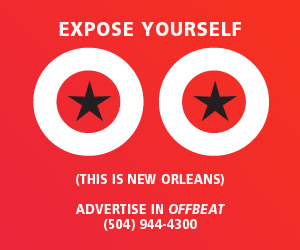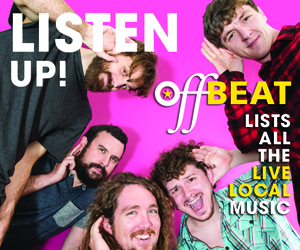Kapo Bravado is used to having a target on his chest. In a green sweater with a red “X” appropriately slapped across the front and his hood draped firmly over his head, the Seventh Ward rapper is in the throes of a classic American bloodsport — battle rap.
Standing mere inches from his opponent, the two exchange personal shots and vivid threats for the shock and awe of the attending crowd — their jeers and cheers will decide a winner when they finish lambasting each other. In the first of a three-round bout, Kapo sends a few stone-cutting jabs at his opposition for being in an interracial marriage. It’s only a set up before delivering a crushing blow: “You always choking in ya battles ‘cause dating a white woman psychologically puts a rope around ya neck.” The crowd howls like they just saw teeth fly out.
The two gladiators ultimately hug it out at the end of the battle, but that’s just the beginning. Clips of Kapo’s performance hit the internet and went viral, earning reposts from Chance The Rapper and Rob49. Social media virality has become the main currency in battle rap, and Kapo is a mercenary wordsmith with a grand plan to properly bring battle rap to New Orleans.
Kapo Bravado’s first shot at a mic was when the then-nine-year-old stumbled across his grandmother’s tape recorder that she used to save church sermons. He would record himself impersonating Wild Wayne and rapping vulgar and likely chaotic bars. His grandmother eventually found Kapo’s audition tapes, and while she disapproved of the cursing, she encouraged his interest in performing.
Hurricane Katrina eventually replanted Kapo from the St. Bernard to the West Coast, where his musical world would expand to new levels. He opened shows for future stars like YG, Ty Dolla $ign, and Casey Veggies in California while building his rap career. In Arizona, a city Kapo calls his other home, his friend and fellow artist Jalopy Bungus pushed him towards battle rap.
“I had only watched like two battles at the time. I had just started getting into battle rap as a fan,” Kapo reminisces over the phone. “[Jalopy] was like, ‘Come battle my homie Mastermind.’ And I did it, and I was always someone who liked crowd reaction. So when I saw that, I was in love with it. I used to do that back in my school days when we rapped at the cafeteria.” That first battle gained the attention of other prominent battle artists like Ill Will and Charlie Clips (Clips was able to flip his battle rap career into a regular appearance on Nick Cannon’s nationally televised diss comedy series Wild “N Out). Kapo’s been deeply invested in the battle rap scene ever since.
Battle rap offers Kapo an avenue to flex his muscles when he isn’t finely tuning his traditional music for mass appeal. “As bad as I wanted to be like Lil Wayne coming up, music [is] not in the space commercially as far as wanting to be the most lyrical. Artistry-wise, I want to be a commercial artist, but I had to simplify things with music,” Kapo says. “So battle rap is my outlet where I can still use big words and [intricate] rhyming. I enjoy that about battle rap. I can still be lyrical.” Now Kapo travels across the country competing in battle rap competitions, forcibly announcing New Orleans’ presence in the rich and historical rap format.
The medium of back-and-forth dissing has roots in a slave game called “Playing the dozens,” where field slaves would make fun of the house servants. “Playing the Dozens” also influenced the early days of hip-hop in the early 80s in New York City. At first, MCs competed against each other by exchanging their best lines, sans the personal digs. That all changed when Kool Moe Dee famously stormed the stage of the Harlem World nightclub in 1981 and dismantled Busy Bee Starski in the first recorded instance of battle rap as we know it today. As rap’s popularity blossomed into the biggest genre in the world, battle rap grew slowly behind it.
Today, battle rap looks more like a pay-per-view boxing event. National rap leagues like SmackURL and RBE (Rare Breed Entertainment) stage exciting events with boisterous crowds, large venues, and big money backing. With so much money supporting the scene, battle rappers can quickly profit off viral moments given the right platform. The South has been slow to catch up to the bustling scene in New York or California, but Kapo says, “The South is on a come up.”
Kapo surmises battle rap had to be simplified before it could spread throughout the South. “[Southerners] are straight to the point, where battle rap used to be more complex. It was more intricate,” Kapo says. “But as battle rap grew, and more people from South Carolina and Georgia and Cali helped simplify battle rap, people slowly started incorporating a mentality of: ‘We about to just be disrespectful.’ Once the South got a dose of that, it was more up our alley.”
New Orleans is known for its love of ribbing, but battle rap doesn’t have the same presence in other Southern battle rap hubs like Houston or Atlanta. One reason is a lack of understanding of battle rap culture and respect. “[New Orleans is] in the beginning phases of learning how to know the disrespect is lighthearted. It’s not serious. I got a bunch of homies who I can’t bring to a battle cause I be like, ‘Y’all too serious, bro,’” Kapo says. Despite the current disconnect, New Orleans isn’t completely devoid of battle rap forefathers.
New Orleans battle rap trailblazers like O’fficial, Kid Kasher, Sire, and Boogie laid the groundwork for Kapo to navigate the space easier. “When [battle rappers from other cities] hear I’m from New Orleans, because of those people, they walk me through doors,” Kapo says. “It’s ‘cause of my talent too, but they be like, “Man, I know it’s only a few of y’all. Here, let me show you this.’”
The foundation for a functional battle rap scene in New Orleans is well in the works. Kapo Bravado has been one of the first local battle artists to go viral, exposing potential fans to the sport right from their timelines. Local rap leagues like Kreo Battle League and Flatline BattleGrounds (formerly known as New Orleans Battle League) are building respectable spaces for competition and camaraderie. Rocq Lee and Joce, according to Kapo, are the next up-and-comers to watch in the battle circuit. The vision for battle rap in New Orleans is becoming clearer by the day.
To push the battle rap culture in New Orleans to never before seen heights, Kapo plans to lead by example. He wants to touch national battle rap stages like SmackURL and RBE as a New Orleans representative and lay more pavement for future artists to follow. In the end, Kapo hopes to create a hub where battle rap fans and competitors can enjoy fiery disses and raucous crowds without the threat of violence. A financially viable place where everyone can prosper.
“Of course, I want to be great, and I will do that already,” Kapo says. “But as far as involving the city, I really want to give [opportunities to] people that are not my family and be able to create a new workplace for multiple families to come eat and enjoy themselves. And for it to be big.”
“I want to put a big red dot on the map for New Orleans in battle rap.”
You can follow Kapo Bravado on Twitter and Instagram for updates on his battles and music.




